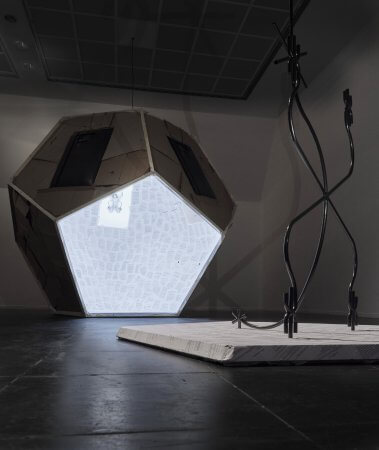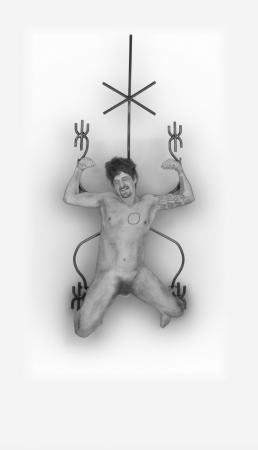Altaira Caldarella, Against fear! On how to let ourselves be moved by the desire to change everything
Guest contribution
Last year, I took part in Gintarė Sokelytė’s coactive art installation. We, the five participants, were suspended from a star-shaped sculpture with ropes attached to our wrists and ankles; we were asked questions and filmed while we were responding to them. It was physically demanding to be hanging there. The questions were also tough: What is Fear to you? What is Power? What is Order? Answering these questions in your own native language as a migrant person raised in Germany is already quite a challenge – but hanging there almost naked, attached to the sculpture, while also being recorded didn’t make it any easier. Unfortunately, I had to call it quits on the last question, which I was actually looking forward to the most. I simply did not have it in me. When we took breaks in between the sessions – we couldn’t record everything all at once because it was simply too exhausting – Gintarė and I kept talking. The green screen behind us. And the sculpture, too. The experience itself set off a whirlwind of thoughts as we continued to work on her piece of art. I was writing my master’s thesis at the time. In this, I was trying to explore the relationship between the desire for social transformation and the satisfaction (or rather, the frequent unsatisfiability) of material needs from a Marxist-Feminist perspective. I was therefore already exploring the questions of how power and physicality are mediated by each other. Whether power is also articulated in our bodies in particular – and if that is the case, by what means exactly?
Within my thesis I have, on the one hand, addressed the question of whether the social conditions of modern societies still allow for the arisal of a need for liberation, to say it with Herbert Marcuse; and, on the other hand, to ask in the words of Agnes Heller, what the material conditions of such a need are currently determined by. At the same time, I have tried to find out whether and how these questions arise in movement contexts, whether they are investigated or even already negotiated as politicizable issues. After first developing a materialist concept of need[1], I have therefore turned to one of the most flourishing social movements of our time: the feminist strike. It emerged from the Ni-Una-Menos-movement in Argentina back in 2017. Its forms of organization and protest, its analyses and aesthetics spread around the globe like a wildfire. In just a few months (!), this movement has led to the emergence of a global feminist counter-power that knows how to analyze, problematize, and fight sexist, racist and fascist violence as well as precarity and poverty as expression of a capitalist totality. In departing from feminized bodies, – the violence and precarity to which they are exposed on a daily basis – the feminist strike develops forms of resistance which stand in the tradition of unionized striking, but at the same time overflow its confines: To strike in a feminist register means to refute not only waged work, but to strike against any type of work which is not free – in other words, which is done involuntarily – or, which is deformed by patriarchal or racist role distributions; or to even strike against any institution in which the structures of democratic self-determination and egalitarian access to resource disposal are insufficient; or, any relationship in which care is not based on reciprocity.
In order to strike in a feminist register, however, we must be able to recognize the social circumstances which we are forced to live with as unfree ones. Our bodies are able to communicate that to us, if we collectively put ourselves in a position to listen to them. The discomfort that we should actually feel within our social conditions of living, is, at the very same time, trained and drawn out of us as FLINTA – for us to continue to function, regardless of current relations of power and violence inflicted onto us. But this discomfort and pain is not simply out of sight out of mind. Or – in other words, out of our bodies, and thus, out of our consciousness. It sits within us. Ingrained, deep down, within us. I would almost claim that it often resides in our bodies inadvertently, both present and inaccessible as only repressed material can be. My impression is that Gintarė’s installation aptly expresses the downtrodden pain that comes with having to maintain our own lives day in, day out under conditions of oppression and violence. While working with Gintarė, I first came to realize that fear could be interpreted as an expression of that pain – and also, as a counter-affect to the desire for social change. Not in such a static opposition, of course; resignation, powerlessness, despair – the list could go on forever – play a significant role, too. But ever since my experience with Gintarė’s work of art, I have found fear to be particularly relevant – because fear is paralyzing.
Who can satisfy their own needs without fear – and who cannot – is mediated by a totality of social relations of domination that must be criticized in their very totality. In this, the syntax of Gintarė’s work allows us to ask in bold and novel ways – how can we help each other to untether our bodies and cast off the ways in which they are bound to the current conditions? How can we learn to strike against the status quo in a feminist register? And last but not least – how can we enable ourselves to gradually set each other free while simultaneously demystifying our specific vulnerabilities and identities as historically and socially produced? This is precisely where the strike comes in. It analyzes abstract relations of power while unfolding its implications from within their situated concreteness, departing from the experience of those who participate in the construction of the strike. In a collective motion of consciousness-raising and knowledge production, the strike develops new strategies of contestation and resistance that – little by little, step by step – aim to transform the world into a caring one while simultaneously liberating care itself from the bondage of upholding patriarchal, colonial and capitalist forms of social relations. To promote these bodily and corporeal forms of feminist consciousness-raising and solidarity, however, we need structures; we need resources, time, and energy. Here it is noteworthy that one of the decidedly feminist characteristics of the strike is that it strikes for the conditions to strike in and of themselves as well. It weaves networks of solidarity and thereby builds the infrastructure that allows for us to recognize all conditions as unfree that are based on the devalued and feminized work of caring – which, under patriarchy, is mostly unpaid and degraded to romantic or familial “love” – to then make each other strive to tear these conditions down by means of striking action.
How many of us are hanging from an invisible “Gintarésque” gallows that forces us to give up before we have even had the chance to develop a need for liberation? At the end of the day, it is a political matter to ensure that there is enough food and enough chairs for everybody who wants to sit at the table with us – we just need to make this be understood and develop new and feminist practices to refute the current state of affairs more globally. Ultimately, caring for one another and care itself should become the starting point and aim of all sociality, a universal task and duty. It is precisely for this reason that care must become contestable in its power-stabilizing deformation, so that its resistant forms and expressions of love, consideration and solidarity can be unfolded – not merely as an anticipation of utopian moments but for these forms of relationality to undergo a transfiguration – for them to be translated into a collective thirst for action. In concluding we could say that awakening a need in people to write “nos mueve el deseo de cambiarlo todo” (Eng.: “we are moved by the desire to change everything”) on banners could be understood as a concrete strategy of political mobilization within the feminist strike movements. It is crucial to try over and over again, enthusiastically and with a certain joy of experimentation, to mobilize our own desire for liberation in order to forge this desire in other people as well – until the “we” that wants to radically change the bigger picture together expands to such an extent that all the work of keeping ourselves and others alive is generalized and the necessary resources and infrastructures for this task are truly accessible to everyone.
[1] With the help of a self-developed notion of need, I have attempted to outline the connection between surplus value production, capitalist forms of social organization and an imperial geopolitical distribution of resources and vulnerabilities, in order to identify these as constitutive elements to any attempt to study the human structures of need within late capitalism – very much in the sense of Max Horkheimer’s assertion that the entire social structure is contained within each and every need.
Altaira Caldarella lives in Frankfurt am Main, is a Marxist feminist, and a member of the Local Consultative Council 2 for ÖkolinX – Antirassistische Liste. Most recently, she wrote her master’s thesis in political theory on the topic of A Need for Liberation. Critical Reflections on the Notion of Need from a Marxist Feminist Perspective. She previously studied philosophy, gender studies and international studies in Kyoto, Bologna and New York City.


